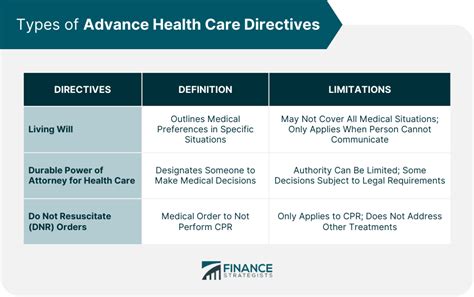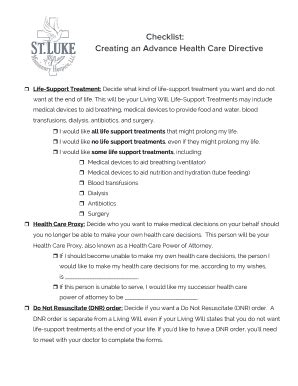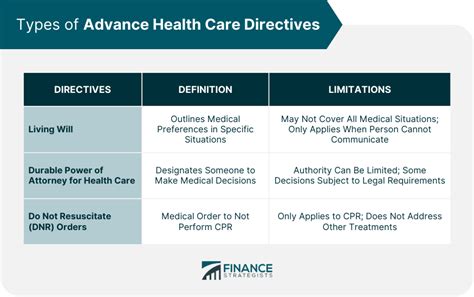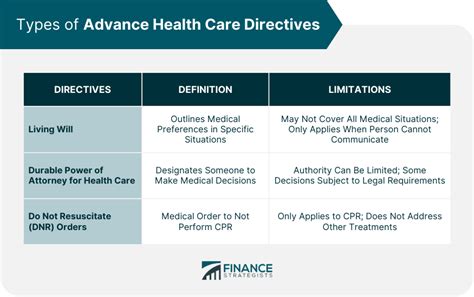Intro
Create a Health Care Directive with our comprehensive guide, covering advance care planning, living wills, and medical power of attorney, to ensure your healthcare wishes are respected and followed.
The importance of having a health care directive in place cannot be overstated. As we navigate the complexities of life, it's essential to consider our wishes regarding medical treatment and end-of-life care. A health care directive, also known as a living will or advance directive, is a document that outlines our preferences for medical treatment in the event we become unable to communicate our decisions. This document is crucial in ensuring that our autonomy and dignity are respected, even when we can no longer speak for ourselves. By having a health care directive in place, we can alleviate the burden on our loved ones and healthcare providers, who may otherwise be left to make difficult decisions on our behalf.
In recent years, there has been a growing emphasis on the importance of advance care planning, with many healthcare organizations and advocacy groups encouraging individuals to create a health care directive. This shift towards proactive planning is driven by the recognition that medical decisions are not just about treating illnesses, but also about respecting the values, beliefs, and preferences of patients. By taking the time to create a health care directive, we can ensure that our medical treatment aligns with our personal values and priorities, even in the face of uncertainty or adversity.
As we consider the importance of health care directives, it's essential to understand the different types of advance directives and how they can be used to guide medical decision-making. A health care directive typically includes a combination of documents, such as a living will, durable power of attorney for healthcare, and do-not-resuscitate (DNR) order. Each of these documents serves a unique purpose, and together they provide a comprehensive framework for ensuring that our medical treatment is consistent with our wishes. By understanding the different components of a health care directive, we can create a personalized plan that reflects our unique needs and preferences.
Understanding Health Care Directives

A health care directive is a document that outlines our preferences for medical treatment in the event we become unable to communicate our decisions. This document is typically created in advance, when we are still able to make informed decisions about our care. A health care directive can include a range of instructions, from the types of medical treatments we want to receive to the level of care we want to receive in a hospital or nursing home. By creating a health care directive, we can ensure that our medical treatment is consistent with our values and priorities, even if we are no longer able to speak for ourselves.
Types of Health Care Directives
There are several types of health care directives, each serving a unique purpose. A living will, for example, is a document that outlines our preferences for end-of-life care, including the types of medical treatments we want to receive and the level of care we want to receive in a hospital or nursing home. A durable power of attorney for healthcare, on the other hand, is a document that appoints a healthcare agent to make medical decisions on our behalf if we become unable to communicate our decisions. A do-not-resuscitate (DNR) order, meanwhile, is a document that instructs healthcare providers not to perform CPR if our heart stops or if we stop breathing.Creating a Health Care Directive

Creating a health care directive is a straightforward process that involves several steps. First, we need to determine what type of health care directive is right for us, based on our individual needs and preferences. We may want to consult with a healthcare provider, attorney, or other professional to ensure that our document is valid and enforceable. Next, we need to choose a healthcare agent, who will be responsible for making medical decisions on our behalf if we become unable to communicate our decisions. We should also consider including a living will, which outlines our preferences for end-of-life care, and a DNR order, which instructs healthcare providers not to perform CPR if our heart stops or if we stop breathing.
Steps to Create a Health Care Directive
The process of creating a health care directive involves several steps, including: * Determining what type of health care directive is right for us * Choosing a healthcare agent * Including a living will and DNR order * Reviewing and updating our document regularly * Sharing our document with our healthcare provider and loved onesBenefits of Health Care Directives

There are several benefits to creating a health care directive, including:
- Ensuring that our medical treatment is consistent with our values and priorities
- Alleviating the burden on our loved ones and healthcare providers
- Providing a clear framework for medical decision-making
- Reducing the risk of conflict or disagreement among our loved ones
- Promoting peace of mind and reducing anxiety about the future
Common Misconceptions About Health Care Directives
Despite the many benefits of health care directives, there are several common misconceptions that may prevent individuals from creating a document. One common misconception is that health care directives are only for older adults or individuals with serious illnesses. However, anyone can benefit from creating a health care directive, regardless of their age or health status. Another misconception is that health care directives are binding and cannot be changed. However, most states allow individuals to update or revoke their health care directive at any time.FAQs About Health Care Directives

What is a health care directive?
+A health care directive is a document that outlines our preferences for medical treatment in the event we become unable to communicate our decisions.
What types of health care directives are there?
+There are several types of health care directives, including living wills, durable powers of attorney for healthcare, and do-not-resuscitate (DNR) orders.
How do I create a health care directive?
+To create a health care directive, we need to determine what type of document is right for us, choose a healthcare agent, and include a living will and DNR order. We should also review and update our document regularly.
Conclusion and Next Steps

In conclusion, creating a health care directive is an essential step in ensuring that our medical treatment is consistent with our values and priorities. By understanding the different types of health care directives and following the steps to create a document, we can promote peace of mind and reduce anxiety about the future. We encourage readers to take the first step in creating a health care directive by consulting with a healthcare provider, attorney, or other professional. Share this article with your loved ones and friends to encourage them to create their own health care directive. Together, we can promote a culture of advance care planning and ensure that our medical treatment is consistent with our wishes.
